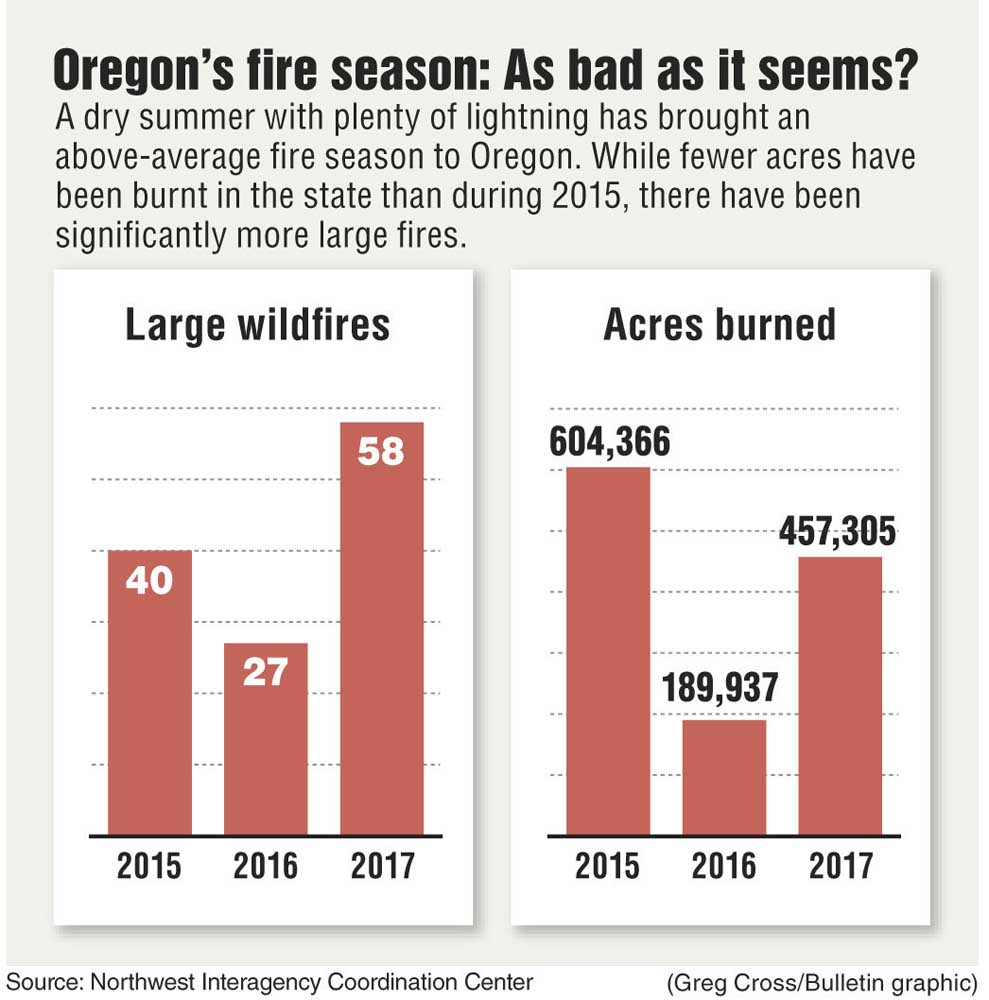How does Central Oregon’s fire season compare?
Published 7:39 am Wednesday, September 6, 2017

- How does Central Oregon’s fire season compare?
For many of Central Oregon’s residents and visitors, the 2017 fire season has been particularly inescapable for the last few weeks, as fires shut down highways, choked the region with smoke and put communities on alert for evacuation.
The recent slate of large fires have been the latest problems in a fire season that has been worse than usual in Oregon through July and August, though not on the level of now-infamous fire years like 1996 and 2003. At least not yet.
“We’re kind of at the mercy of nature right now,” said Kevin Stock, acting deputy fire staff officer for the Deschutes National Forest.
Central Oregon has seen 18 large fires — classified as fires that have burned at least 100 acres in the woods, or 300 acres of grassland — so far this season, according to Susie Heisey, public information officer with Central Oregon Interagency Dispatch Center.
Some, like the Cinder Butte Fire, covered lots of ground away from large population centers. But more recent fires, particularly the Milli Fire, have made life difficult for Bend residents and strained the region’s fire suppression capacities.
“You reach a point where there’s more fire on the ground than you have resources to deal with,” Stock said. “And you have to make hard choices.”
Oregon’s fire season runs from the end of June, when nonnative grasses and other vegetation begin to dry out, through the start of October, as longer nights and higher humidity put the brakes on most lingering fires, according to Carol Connolly, public information officer for the Northwest Interagency Coordination Center.
The conditions that led to an above-average fire season were in place well before June. Stock said Central Oregon’s wet winter and spring spurred rapid growth for grasses and underbrush in the region, which can carry fires. Those grasses dry out normally during the summer, but this summer has been especially warm and dry. The result, Stock said, was a fire season with a lot of grassland fires early in the summer.
“You have a wet spring and summer, and then these grasses just start to dry out,” Stock said.
He added that higher-elevation portions of the forest retained snow and moisture well into the summer, but eventually the hot, dry weather took its toll there as well. Bend had its warmest August on record, with an average daily temperature that was 5 degrees above normal, according to data provided by the National Weather Service’s Pendleton office. Rob Brooks, forecaster for the National Weather Service, added that Redmond tied a daily temperature record on Aug. 28, and set one on Aug. 2.
Just as significantly, Bend received only a trace amount of rainfall all month, but the region has received plenty of lightning, a bad combination for firefighters.
Connolly said 30,000 lightning strikes have been recorded in Oregon and Washington so far. Normally, summer lightning in Central Oregon is accompanied by at least a bit of moisture, but that hasn’t been the case this year. As a result, the majority of the fires in the Central Oregon high country, including the Milli Fire, were started by lightning.
So far, the situation in Central Oregon has mirrored what’s been occurring across the state. With a little over half of the fire season in the books, Oregon is on pace for fire totals that look more similar to 2015, which was dry throughout the year, than the more moderate 2016.
“When you look historically, what we experienced in 2016 was more of a normal fire season,” Connolly said.
Through Aug. 29 — the latest day that the coordination center, which monitors large fires in Oregon and Washington, has compiled data — 58 large fires have burned 457,305 acres in Oregon, more than twice the totals in 2016 through Aug. 29 of that year.
In 2015, only 40 large fires had started in the state as of that date, though they burned significantly more acreage — 604,366 acres — than this year’s fires have so far. According to the Central Oregon Interagency Dispatch Center, 23 fires were burning in Oregon as of Friday afternoon.
So far, the fires have proven costly. Jennifer Jones, public affairs specialist for the U.S. Forest Service, wrote in an email that the Forest Service has spent $140 million on fire suppression in Oregon and Washington so far this year, a total that includes everything from staffing incident management teams to supplying aircraft with fuel and fire retardant. The total is already significantly more than the $97 million spent all of last year in the region, according to Jones.
In Central Oregon, one of the most direct impacts has been the smoke from the fires. Using the U.S. Environmental Protection Agency’s air quality index, the air in Bend was “moderate” or worse for 28 of the 31 days in August, according to data provided by Oregon’s Department of Environmental Quality. This was due to smoke from fires in British Columbia and the Willamette Valley, and later from the Milli Fire. In August 2016, the air quality in Bend remained “good” the entire month.
In Sisters, the pollutants in the air reached levels not seen since 2012, when the Pole Creek Fire burned 26,000 acres south of town, according to Mark Bailey, air quality manager for Oregon DEQ.
“We had numbers where we had to reset the monitors to make sure they were accurate,” Bailey said.
For firefighters, the hardest thing about the season has been the steady stream of new incidents across the Western United States. Stock said there’s definite fatigue going from assignment to assignment.
“There’s really been no break,” he said. “You’ve got incident management teams on their fourth assignment, their fifth assignment this year.”
As fall approaches, overnight lows will drop and humidity levels will rise, bringing an end to the fire starts. More immediately, however, the weather will bring more of the same. The high temperatures for Labor Day weekend prompted a Red Flag Warning on Saturday from the weather service. Connolly said the 10-day forecast for Central and Eastern Oregon is expected to bring more lightning without rain.
“As we move into Labor Day, we’re once again concerned about human-caused wildfires,” Connolly said.
— Reporter: 541-617-7818, shamway@bendbulletin.com






